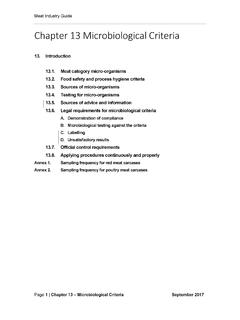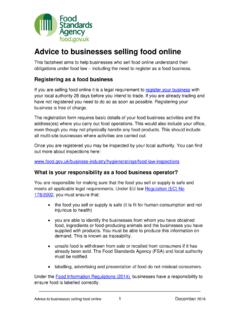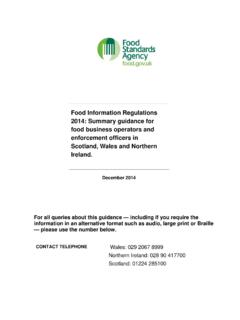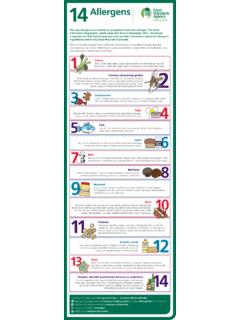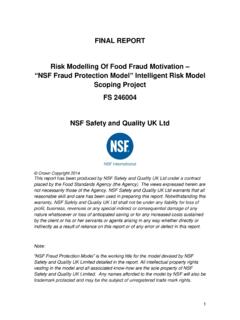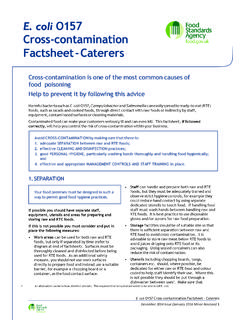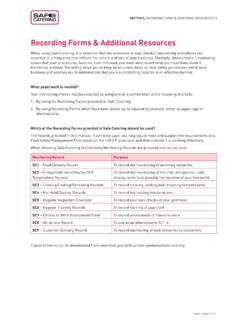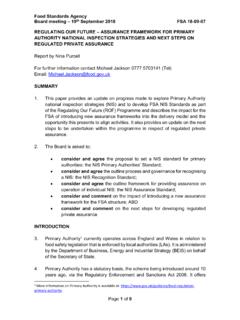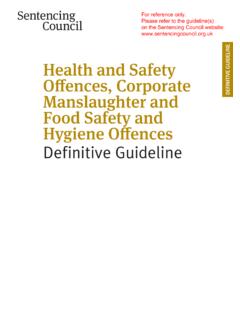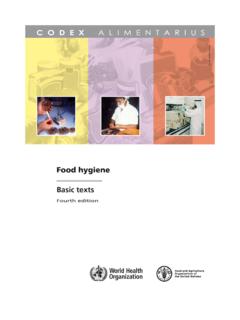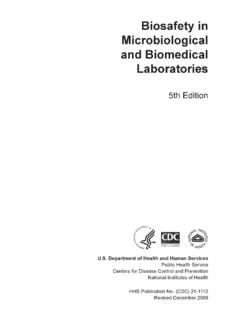Transcription of The food Safety Act 1990 - A guide for businesses
1 THE food Safety ACT 1990 A guide FOR food businesses THE food Safety ACT 1990 A guide FOR food businesses 2009 Edition If you require this information in an alternative format such as audio, large print, Braille please contact us. CONTACT TELEPHONE: Chandra Ambigaipagan 020 7276 8166 THE food SAFET Y ACT 1990 A guide FOR food businesses 2 Summary Intended audience: The Guidance Notes are intended for food businesses . Regional coverage: The Guidance Notes are applicable to England, Scotland and Wales. Legal status: The Guidance Notes are intended to provide regulatory guidance on the food Safety Act 1990. Purpose: The Guidance Notes provide guidance on the requirements of the food Safety Act 1990 in the light of amendments to the Act and other relevant legislation. REVISION HISTORY Revision No. Revision date Purpose of revision Revised by 1 14 April 2008 Draft for consultation Bill Drennan 2 23 April 2009 Final version Bill Drennan THE food SAFET Y ACT 1990 A guide FOR food businesses 3 CONTENTS INTRODUCTION.
2 5 Intended Audience .. 5 Purpose and Legal Status of Guidance Notes .. 5 Foreword .. 5 Summary of Responsibilities .. 7 THE food Safety ACT 1990 .. 8 MAIN AIMS, SCOPE AND DUTIES .. 8 What is the food Safety Act 1990? .. 8 What does the Act aim to achieve? .. 8 What is the scope of the Act? .. 8 Does the food Safety Act stand alone? .. 8 What does the Act mean by food ? .. 9 What activities are covered by the Act? .. 9 Does the Act affect farmers and growers? .. 10 What does the Act mean for food importers? .. 10 What does the Act require food businesses to do? .. 10 THE MAIN 11 What are the main offences under the food Safety Act? .. 11 What is meant by rendering food injurious to health ? (section 7) .. 11 When is food not of the nature or substance or quality demanded ? (section 14) .. 12 How can food be falsely or misleadingly described or presented ? (section 15) .. 12 What penalties can be imposed under the Act? .. 13 DEFENCES TO THE OFFENCES UNDER THE food Safety ACT 1990.
3 14 What is the legal defence of due diligence ? .. 14 Can retailers of own label products offer the defence of due diligence ? .. 14 Can retailers of branded goods offer the defence of due diligence ? .. 15 What other defences are there? .. 15 THE food SAFET Y ACT 1990 A guide FOR food businesses 4 ENFORCING THE ACT .. 15 Who enforces the Act? .. 15 What is the role of the food Standards Agency (FSA)? .. 16 What is the role of Local Government? .. 16 What are the roles of public analysts and food examiners? .. 17 How is the Act enforced? .. 17 What powers of entry do authorised officers have? .. 17 What is meant by premises'? .. 17 What are the limits to the authorised officers powers of entry? .. 18 Can officers disclose all the information they find during a visit? .. 18 Can authorised officers take samples of food ? .. 18 What happens if authorised officers find suspect food ? .. 18 What happens if food is seized but then not condemned?
4 19 What other powers may be used under the Act by authorised officers when inspecting food premises? .. 19 What are emergency control orders? .. 20 What are food Alerts? .. 20 Is there an appeals procedure against actions under the food Safety Act? .. 21 APPENDIX 1 - SOME USEFUL ADDRESSES .. 22 CENTRAL GOVERNMENT .. 22 CO-ORDINATING BODIES .. 23 PROFESSIONAL BODIES .. 23 INDUSTRY BODIES .. 24 APPENDIX 2 - KEY PROVISIONS OF THE food Safety ACT 26 PART I: PRELIMINARY .. 26 PART II: MAIN PROVISIONS .. 26 PART III: ADMINISTRATION AND ENFORCEMENT .. 27 PART IV: MISCELLANEOUS AND SUPPLEMENTAL .. 28 THE food Safety ACT 1990 A guide FOR food businesses 5 INTRODUCTION Intended Audience 1. The se Guidance Notes are aimed at food businesses . Purpose and Legal Status of Guidance Notes 2. The Guidance Notes have been produced to provide informal, non-binding advice on the legal requirements of the food Safety Act 1990 and should be read in conjunction with the legislation itself.
5 The text should not be taken as an authoritative statement or interpretation of the law, as only the courts have this power. Every effort has been made to ensure that these Guidance Notes are as helpful as possible. However, it is ultimately the responsibility of individual businesses to ensure their compliance with the law. businesses with specific queries may wish to seek the advice of their local enforcement agency, which will usually be the trading standards/environmental health department of the local authority. There is further relevant information on the food Standards Agency website . Foreword 3. The Safety of food is vital to all consumers and food businesses . Consumers must have confidence that the food they buy and eat will be what they expect, will do them no harm and that they are protected from fraud. The importance of this confidence cannot be underestimated for businesses . 4. Although food Safety legislation affects everyone in the country, it is particularly relevant to anyone working in the production, processing, storage, distribution and sale of food , no matter how large or small the business.
6 This includes non-profit making organisations. 5. As a food business, you should familiarise yourself with the food Safety Act 1990 which, although it has been changed substantially following the introduction of European food Safety legislation, remains very important primary food Safety legislation. It has provided the basis and a flexible framework for much domestic food law and applies to the whole of Great Britain1. It concentrates on fundamental issues and leaves the detail to secondary legislation (which is not specifically covered in this guide ). 6. This guide updates the previous guide The food Safety Act 1990 and You , issued in 1996 and reprinted in 1997 and 1999. It focuses on the aspects of the Act which are of most significance to food businesses , what the Act requires; 1 Similar legislation exists in Northern Ireland, the food Safety (Northern Ireland) Order 1991.
7 FSA Northern Ireland is producing a separate guide to this order. THE food Safety ACT 1990 A guide FOR food businesses 6 the offences under the legislation and possible defences; other actions which can be taken by food authorities; possible defences to these actions. advise managers of medium-sized and larger food businesses to readthe guide in detail and to make the information about the main offences knownto all relevant staff. Small businesses should all note their responsibilitieslisted at the end of this introduction and use the rest of the guide to help thembetter understand these, and for reference about the defences to any legalaction and the powers available to enforcement 1999 there have been significant changes in food Safety law in theUnited Kingdom. In particular, the European Union (EU) adopted the GeneralFood Law Regulation (Regulation (EC) 178/2002), which came fully into effectin 2005. This Regulation created new laws on food Safety , traceability,withdrawal and recall of products.
8 Offences for breaches of these laws havebeen put into effect in Great Britain by the General food regulations 2004,which has also made changes to the food Safety Act 1990 itself. In addition,the food Safety Act 1990 (Amendment) regulations 2004 changed thedefinition of food in the food Safety Act to bring it in line with Regulation(EC) 178/2002. Guidance Notes on the General food Law Regulation (EC)178/2002 were published in 2007. These are available .(small businesses may wish to refer in particular to the summary at paragraph8 of those Guidance Notes). hygiene requirements for businesses are made under powers given by the food Safe ty Act 1990 and the European Communities Act 1972 rather than in the Act itself. These are deal t with separately under food law and are covered by the food hygiene regulations 20062 (as amended). There is detailed guidance on food hygiene legislation Most hygiene enforcement provisions are now made under this legislation rather than the Act.
9 Other legislation made under the Act is not covered in this guidance concentrates on what the main provisions of the Act meanrather than what has to be done to set up a safe food system. It does notprovide information on the requirement3 to operate a food Safety managementsystem based on HACCP (Hazard Analysis Critical Control Point) on this and the Agency s guidance to help small businessescomply with the requirement can be found .2 There are separate versions of the food hygiene regulations 2006 in England ( ), Scotland ( ) and Wales (Welsh ( )) 3 Article 5(1) of Regulation (EC) 852/2004 THE food Safety ACT 1990 A guide FOR food businesses 7 Summary of Responsibilities 11. The Act applies to all types of food businesses . 12. Your main responsibilities under the Act are: to ensure you do not include anything in food , remove anything from food or treat food in any way which means it would be damaging to the health of people eating it; to ensure that the food you serve or sell is of the nature, substance or quality which consumers would expect; to ensure that the food is labelled, advertised and presented in a way that is not false or misleading.
10 THE food Safety ACT 1990 A guide FOR food businesses 8 THE food Safety ACT 1990 MAIN AIMS, SCOPE AND DUTIES What is the food Safety Act 1990? 13. The food Safety Act 1990 is wide-ranging legislation on food Safety and consumer protection in relation to food throughout Great Britain. What does the Act aim to achieve? 14. The main aims of the Act are: to ensure that all food meets consumers expectations in terms of nature, substance and quality and is not misleadingly presented; to provide legal powers and specify offences in relation to public health and consumers interest; and to enable Great Britain to fulfil its part of the United Kingdom s responsibilities in the European Union. What is the scope of the Act? 15. The Act covers activities throughout the food distribution chain, from primary production through distribution to retail and catering. 16. The Act gives the Government powers to make regulations on matters of de tail.

